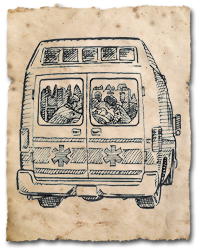Why Are We Making Slow Progress Against Cardiac Arrest?
By Doug Gillett
 |
Cooldown: Read the story of a UAB patient whose life was saved by induced hypothermia treatments. |
Your chance of surviving cardiac arrest may depend on chance itself. If you happen to be close to help when it happens, you’re in luck; the American Heart Association reports that the chance of survival decreases by 10 percent for every minute a person goes without care. But if you’re in rural Alabama, where volunteer emergency medical responders frequently drive long distances to provide treatment, the situation isn’t so bright. Less than 2 percent of patients in the state survive out-of-hospital cardiac incidents.
Why are the numbers still so low? One reason has to do with the large, complex teams—everyone from paramedics to nurses to physicians—who respond to cardiac incidents. Henry Wang, M.D., UAB associate professor of emergency medicine, says it’s tough for cutting-edge knowledge to “trickle down” to first responders. That’s something he and his colleagues hope to change by investigating new avenues to improve pre-hospital care of cardiac arrest as part of a 10-center National Institutes of Health (NIH) initiative.
In From the Cold
One of those solutions, induced hypothermia, has proven to be an extremely effective treatment for patients surviving an initial cardiac arrest, but few emergency physicians perform it. “It’s very simple—cooling blankets, special cooling catheters, or even cooled IV fluid drop the patient’s temperature to 34 degrees Celsius for 12 hours,” Wang says. “It improves metabolism and profoundly improves the chances of survival. Yet there’s a misconception that it’s a complicated protocol that can only be carried out by a university hospital.”
Small modifications to existing treatments also may make an impact, Wang says. “We’re testing different ways of providing CPR chest compressions,” he says. “The most recent American Heart Association guidelines advocate continuous, uninterrupted chest compressions—push hard, push fast, don’t stop—and that’s hard to do. We want to see if stopping periodically to observe heart rhythms and administer medications up front might be more advantageous than an early, concentrated period of chest compression.” Wang’s research team also is testing a new device—a simple valve placed on top of a breathing tube—that could improve blood flow in the heart during chest compressions.
Shannon Stephens, clinical research coordinator for UAB’s emergency medicine department, says the new methods could pay huge dividends on a relatively small investment. “We could finally see substantive improvements in the survival of cardiac arrest, not only in Alabama but also around the world,” he says. “If the new CPR protocol is successful, it could be disseminated in underserved countries. It costs nothing; there’s no $30,000 machine or $1,000 drug associated with it.”
More Than Survival
Stephens adds that these advances are only one part of a long treatment process. “Our focus used to be the up-front effort to restart the heart, as though that was the entire goal,” he explains. “It’s like a car with a stalled engine. Restarting it doesn’t mean you’ve solved the underlying problems—maybe only two of four pistons are at full speed, and there’s still a lot of work required to get the whole engine running properly.
“Even if you survive the initial cardiac arrest, many other elements are needed to ensure that you survive the trip to the hospital and the stay once you’re there,” Stephens says. He hopes future NIH-led research trials will identify additional improvements to care. “We need organized national efforts to find the best solutions,” he says.